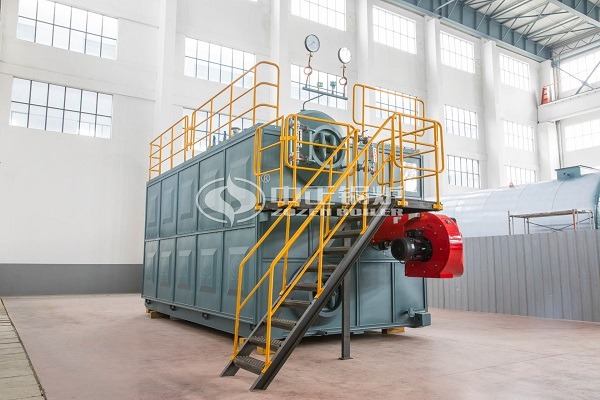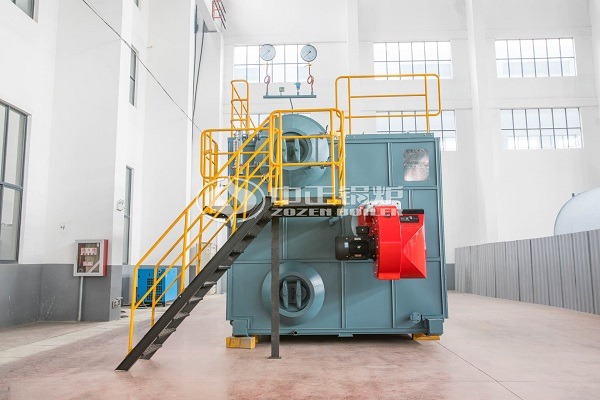 Structure: Horizontal
Structure: Horizontal
Installation Method: Quick installation boiler
Combustion Method: Chamber combustion
Uses: Steam for production process, large-scale central heating, residential heating in winter etc.
Boiler Introduction: “D” type water tube boiler body is composed of upper drum, lower drum, header, water wall, convection tube bundle, furnace and burner. Except for the furnace and burner, all other parts are subject to the saturation pressure of the boiler.
Features of Water Tube Boiler
- In the arrangement of the heating surface of the D-type boiler, the scale and quantity can be easily increased or decreased, and it is easy to form boilers with different evaporation capacities.
- The convection tube bundle of the D-type boiler is located beside the furnace. It is not erected above the furnace, so as the boiler evaporation increases, the boiler height will not increase significantly.
- When the boiler evaporation capacity increases, if the boiler volume shrinks, the furnace volume heat load must be appropriately increased to reduce the boiler volume and weight per unit evaporation capacity. With the development of combustion technology, the fuel can be perfectly burned in the furnace, but the temperature of the furnace will increase due to the increase of combustion intensity. Refractory brick walls are difficult to adapt to this working environment. Especially when inferior residual oil is burned, it will corrode the refractory brick wall. For this reason, D-type boilers are now generally equipped with water-cooled heating surfaces on the furnace wall, thereby reducing the direct radiation of the high-temperature flame on the furnace wall and the erosion of the furnace wall by the burning of inferior fuel oil. This not only plays a role in cooling and protecting the furnace wall, but also because the evaporation rate of the heating surface of the water wall is high, it can also increase the evaporation rate of the heating surface of the entire boiler. At the same time, the excessive increase in the temperature of the smoke at the outlet of the furnace is suppressed.
- As a result of mastering the application technology of water wall, for boilers with different evaporation capacity. The temperature of the flue gas at the outlet of the furnace can be controlled by increasing or decreasing the heating area of the water-cooled wall under the conditions of different furnace volume heat loads. So that the furnace has a certain temperature level, which can not only ensure good combustion, but also protect the furnace wall. Moreover, at the exit of the furnace, the convection tube bundle will not be coked and corroded due to the burning of inferior residual oil.
Water Tube Boiler Construction

Upper Steam Drum
Although the upper drum is not the heating surface, it has the following important functions in the water tube boiler:
- Because a certain amount of water can be stored in the upper drum (about 1/3 of the boiler’s storage capacity). When the amount of water supply and the amount of steam produced are unbalanced in quantity, the fluctuation of the water level in the drum can temporarily be used to cope with it. Thereby reducing the requirements for water supply regulation. In addition, it makes the boiler have a certain heat storage capacity, when the heat output from the boiler to the outside and the heat supplied to the boiler are unbalanced. The water in the upper drum can temporarily release or absorb part of the heat to slow down the passiveness of the steam pressure, thereby reducing the requirement for combustion regulation.
- The upper drum conveys the boiler water to the evaporation heating surface tube, receives the steam-water mixture from the evaporation tube bundle, and separates the steam-water in it. The boiler receiving feedwater and supplying saturated steam also need to pass through the upper drum. Therefore, the upper drum is a gathering point of the soda system, and the upper drum is also the place where some important accessories are installed.
- The feed water is treated in the upper drum, and through the upper drain in the upper drum, the boiler water with high salinity in the boiler and the oil and foam floating on the water surface are eliminated to avoid Scale on the heating surface and prevent corrosion of the heating surface.
- The feed water is preheated and degassed in the upper drum. Boiler feed water temperature is lower than the pot water, and dissolved oxygen, into the upper pot barrel is heated by the surrounding pot water to near saturation temperature. At the same time, dissolved oxygen is also precipitated, thus reducing the temperature stress of the upper drum and the corrosion of oxygen on the heating surface.
Header and Lower Water Drum
Neither the header nor the lower water drum are heated surfaces. The header is used to fix the water wall tube to and form a normal water circulation in the water wall tube. The lower drum is used to fix the evaporative heating surface pipe except the water wall and connect its water circulation, and it also has a certain water storage capacity. They can remove the sludge precipitated in the pot water through the sewage.
Evaporating heating surface
The heating surface that is directly heated to produce saturated steam in the boiler is called the evaporation heating surface. The water wall tube and the first three rows of convection tube bundles (ie anti-slag tube) near the furnace, the flue gas transfers heat to the pot water in the tube by means of radiation heat transfer, so it is called the radiant heating surface. The remaining evaporating tube bundles receive the heat transferred by the flue gas through convective heat exchange, so they are called convective heating surfaces.

Furnace Hearth
The furnace hearth is a place where fuel oil is atomized and burned. Its function is to provide enough space so that the fuel can be fully burned and the heat generated by the combustion will not be lost to the outside of the boiler.
The furnace hearth is composed of refractory brick walls and water-cooled walls. The water wall is the evaporation heating surface pipe laid on the inner wall of the furnace. Because it absorbs the radiant heat of high-temperature flame and flue gas, it can protect the refractory brick from overheating and burn out, and it has the function of cooling the furnace wall. At the same time, it can increase the boiler’s evaporation rate. By arranging different numbers of water wall heating surfaces at different parts of the furnace, the temperature and temperature field distribution of the flue gas in the furnace are controlled. This ensures good combustion in the furnace. It is an important part of the evaporative heating surface of the entire boiler. The radiant heat absorbed by the water wall accounts for about 1/3 of the heat absorbed by the entire heating surface of the boiler. The flue gas is reduced from the theoretical combustion temperature (about 2000K) to the furnace outlet temperature (1500~1750K). After the flue gas leaves the furnace, it flows into the evaporation tube bundle.
Burner
The burner of an oil-fired boiler is composed of an atomizer or a fuel injector and an air distributor. The fuel injector atomizes the fuel sent into the furnace into oil mist, and the air distributor introduces the combustion-supporting air into the furnace reasonably, so that it can be fully mixed with the atomized fuel in time.
“D” Type Boiler System and Boiler Accessories
- Fuel system
The fuel pump in the fuel system pumps the fuel from the tank to the daily fuel tank, and then uses the fuel pump to pump out the daily fuel tank. After pressurizing, heating and filtering, it is finally sent to the injector for atomization. This system is usually divided into fuel supply system and fuel working system based on the daily fuel tank. - Water supply, condensate, steam system
The water supply system is composed of boiler feed water delivery pipes, feed water heaters, feed water pumps and feed water regulating valves. The condensate system includes the pipeline from the deaerator and other equipment and the equipment and valves on the pipeline. The steam system includes steam pipes and various valves on the pipes. - Ventilation system
The function of the ventilation system is to send outside air into the furnace for fuel combustion, and to discharge the combustion products (flue gas) out of the boiler to the atmosphere. Due to the flow of air and flue gas, various flow resistances will be generated. If the natural ventilation force generated by the chimney is used to overcome these flow resistances, it is called natural ventilation. Obviously, the wind generated by this type of ventilation is very small. Increase the height of the chimney to improve natural ventilation. A ventilation system that uses fans to overcome various flow resistances is called mechanical ventilation. Mechanical ventilation is divided into: positive pressure ventilation, negative pressure ventilation and balanced ventilation. The air blower is used to send air into the boiler and press the flue gas from the boiler to the atmosphere, which is called positive pressure ventilation. Exhaust the flue gas from the boiler into the atmosphere with an induced draft fan, and suck the air into the furnace, which is called negative pressure ventilation. At the same time, the use of blower and induced draft fan for ventilation is called balanced ventilation. - Boiler accessories and monitoring instruments
Boiler accessories and monitoring instruments are necessary devices to ensure the safe and economical operation of the boiler, including:
1. As an accessory to ensure the safe operation of the boiler: water level gauge, safety valve, pressure gauge and temperature gauge indicating steam parameters;
2. As accessories for monitoring combustion: wind pressure meter, CO2 indicator, oxygen meter, smoke mirror, etc. - Boiler automation system
In the automatic boiler, the automatic system includes: automatic water supply process regulation system; Automatic control system for combustion process; Superheated steam temperature automatic regulation system and various safety protection system.